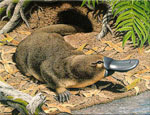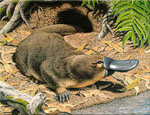[ Opisthokonta | Metazoa | Eumetazoa | . . .
. . . | Monotremata | Ornithorhynchidae | Ornithorhynchus ]
 Courtesy of Australian Geographic Journal
Courtesy of Australian Geographic Journal
|
| Taxonomy: | Eukaryota | Opisthokonta | Metazoa | Eumetazoa | Bilateria | Deuterostomia | Chordata | Craniata | Vertebrata | Gnathostomata | Teleostomi | Euteleostomi | Sarcopterygii | Dipnotetrapodomorpha | Tetrapoda | Amniota | Mammalia | Prototheria | Monotremata | Ornithorhynchidae | Ornithorhynchus |
| Common: | duck-billed platypus, duckbill platypus, platypus (German: Schnabeltier) |
| Comment: | Ornithorhynchus anatinus, or duck-billed platypus, is an important model organism for developmental and evolutionary studies. Platypuses have a tail shaped like that of a beaver, webbed fore- and hindfeet, and a muzzle shape similar to the bill of a duck. The platypus is a monotreme and one of three mammals that lay eggs and do not give birth to their young. It is also the only known mammal that produces venom. The platypus lives only in the freshwater systems of eastern Australia and Tasmania. Sequenced animal: A female nicknamed 'Glennie' (collected at the Upper Barnard River on Glen Rock Station, New South Wales). |
|
|

|
Go to NCBI Taxonomy (9258) |
|
|
|  |
Encyclopedia of life |
|
|  |
Wikipedia |
| Publications: |
Cortez D, Marin R, Toledo-Flores D et. al. 
( 2014)
Nature 508, 488-493.

Warren WC, Hillier LW, Marshall Graves JA et. al. 
( 2008)
Nature 453, 175-183.

|
|
|
Ornithorhynchus anatinus isolate Pmale09
|
[ Opisthokonta | Metazoa | Eumetazoa | . . .
. . . | Monotremata | Ornithorhynchidae | Ornithorhynchus ]
 Courtesy of Australian Geographic Journal
Courtesy of Australian Geographic Journal
 Courtesy of Australian Geographic Journal
Courtesy of Australian Geographic Journal










